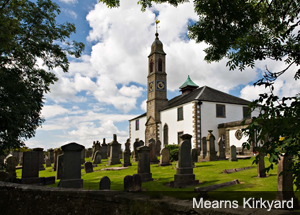
Welcome to the Mearns Kirkyard Project!
Whether you are a genealogy researcher or a casual browser, you are invited to open the pages of our record where you will find information about the Mearns of the past and about those who lived and worked here.
We are modestly confident that you will find elements of the record to be of interest.
Initially the project was limited to the recording of the gravestone inscriptions within the graveyard. However as the work advanced, we were encouraged to apply for a lottery grant. The award enabled the team to create a more comprehensive record accessible to a wider body of researchers.
If you have not previously been engaged in work and study of this nature we would ask you to reflect that many Kirkyards are unrecorded, and that only endeavours such as ours will ensure that the inscriptions will not be lost.

About the Kirk
It is believed that some form of Church has existed on this site from c.800 AD but the earliest written record appeared c.1190 when a priest, Helia de Perthic, gifted the newly founded Anglo - Norman Church to Paisley Abbey.
Through the centuries Mearns Kirk has steadfastly served its parishioners and has undergone several structural changes as it has sought to meet the needs of its times. The main square section of the present building dates from 1813 but in 1932 a Session House, Vestry, and Chancel were added to the west, east, and north sides and the interior was altered and refurbished.
Maintaining the internal beauty of the building is an ongoing task. In 2001 a major restructuring and enlarging of the Vestry area produced a fine entrance vestibule, while the raising and extending of the Chancel floor has created a most attractive open area in the centre of the Church which features in the National Buildings Record as a building of architectural merit.
The Kirkyard which surrounds the Church
has been the final resting place of many parishioners -
the oldest legible inscription dates back to 1611; the last
interment occurred in the 1950s. The gate at the entrance
to the Kirkyard has hollow gate posts which acted as sentry
boxes in the early 19th century when graveyard watchers
guarded the graves at night against “resurrectionists”,
grave robbers, who supplied anatomists with corpses.
This historic building and its Kirkyard welcomes you!